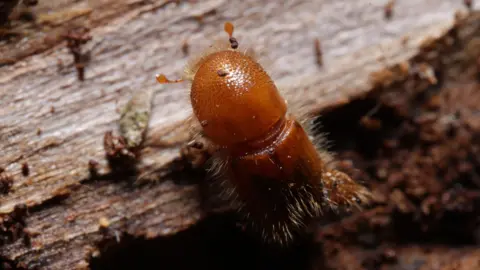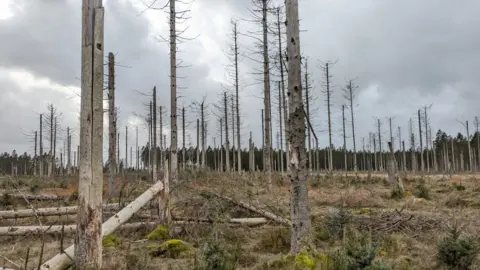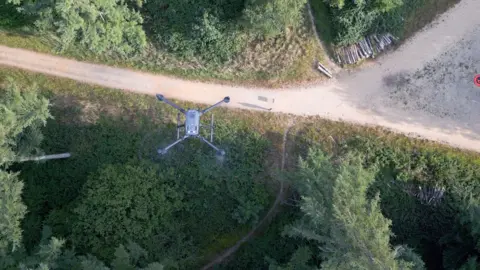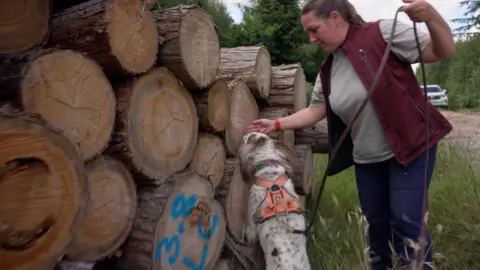AI Research
How video games are keeping romance alive – one level at a time | Games

Last week, Radio 4’s Woman’s Hour talked about the role of women in the video games industry. It featured interviews with gaming insiders, from esports presenter Frankie Ward to members of the inclusive online community Black Girl Gamers. It was wonderful to hear so many disparate, expert views on games culture being given so much time on the show.
One of my favourite moments was when presenter Nuala McGovern read out some listener responses to the question: why do you play video games? “I don’t think there’s enough recognition of gaming as an activity for couples,” one replied. “My husband and I bonded over our shared love of gaming. Our honeymoon was playing Borderlands 2 while we saved for a flat deposit, and now, with a young child, we explore stories, we visit new worlds, we solve mysteries … There is an underappreciated romance to gaming – we communicate, encourage, collaborate and celebrate together. It’s a joy.”
I found this very moving because I know many friends who met their partners through playing games, and who see the act of gaming together as a much more textured and immersive experience than wallowing in front of a TV series. I’ve lost count of the number of couples who’ve told me they especially enjoyed playing survival horror games such as Resident Evil and Silent Hill together – even though they are strictly single-player experiences. Sharing scary games is a way of lessening the terror while exploring an abandoned orphanage or science lab. It introduces an element of physicality – as does taking it in turns to use the joypad, swapping it from hand to hand, like an intimate gift.
Playing a video game with someone you’re falling in love with, meanwhile, gives you a new perspective on who they are and what they can do. It’s helpful to know your partner is brilliant at solving spatial puzzles, or that they’re determined and resourceful when faced with tricky tasks. If nothing else, it’s a hint at exactly how it’s going to go when you end up assembling an Ikea bookshelf together. Recently, I wrote about the use of video games in child therapy, and one of the counsellors I spoke to, Ellie Finch, is looking at doing couples therapy in Minecraft because it’s often a space where all the people in the relationship feel comfortable. I suspect that challenging clients to build a simple house together will tell her more about their interpersonal dynamic than two hours of talking.
There is a lot of romance in experiencing new places together, getting lost and combining skills to help each other out of calamities. There is sweetness in a shared Stardew Valley or Animal Crossing escapade; there is intellectual challenge in quiet evenings with Blue Prince or Split Fiction. For too long, gaming was seen as the preserve of lonely young men, a hobby too guarded and insular for lovers; now everyone can play and the digital world is opening up. Lots of people are now effectively using online games such as Final Fantasy XIV and GTA Online as highly elaborate dating sites, sometimes meeting and forming relationships in real life. Games remove many barriers – the expense of going out, the vulnerability of meeting strangers – they are test spaces for the romance-curious.
I hope that as this generation of gamers age, they will keep playing together. I hope they show their grandchildren the levels they designed in Super Mario Maker, or the beautiful apartment they constructed in The Sims – the digital photo albums of entire lifetimes together. Games have so much to tell us about each other, if we are open to play and being playful.
What to play
Last year I reviewed the Super Pocket from Blaze Entertainment, a funky little handheld capable of playing a range of cartridge-based retro games. Now there’s a new Super Pocket Neogeo edition, inspired by the cult 1990 console by the Japanese manufacturer SNK, in the familiar black and gold colouring. It comes loaded with 14 Neogeo titles and it’s a really intriguing selection, from bona fide classics such as side-scroller Metal Slug X and formative fighting game Fatal Fury. There are lesser known gems, too, including luscious beat-’em-ups Top Hunter: Roddy & Cathy and Mutation Nation. The Super Pocket will also run all the other carts designed for Blaze’s Evercade consoles, opening a whole galaxy of well-emulated retro delicacies.
Available on: Super Pocket console
Estimated playtime: countless nostalgic hours
What to read
-
VGC has a translation of a recent Japanese interview with Ico and Shadow of the Colossus designer Fumito Ueda, who claimed that “the age of game mechanics is over”. His assertion was that developers were no longer inventing new mechanics and were focusing on existing design techniques as well as the look and feel of games. It’s a provocative assertion, perhaps gaming’s equivalent of Francis Fukuyama’s The End of History and the Last Man – but I hope he’s wrong.
-
Valve has been removing adult games from Steam, reportedly as a result of pressure from credit card companies. An Australian anti-porn group called Collective Shout has claimed responsibility – the organisation recently published an open letter to payment processors such as PayPal and Mastercard claiming that games available on the digital store featured child abuse and incest. Vice has gathered reactions from Steam customers.
-
Somehow, I’m not surprised by the discovery that Nintendo employees rarely leave the company. Games site GoNintendo has shared some employment data from the company showing that staff in Japan stay with the company for 14.4 years on average, with people at offices elsewhere staying between eight and a half and 10 years. It’s nice to know that, amid the crisis in the industry, with thousands of staff being laid off, at least one major company apparently knows how to nurture its workforce.
after newsletter promotion
What to click
Question Block
This question came from Jamie, via email:
“I recently visited Orford Ness, the National Trust site in Suffolk that was used for experiments throughout the 20th century by the Ministry of Defence. I was struck by how much it reminded me of games like The Last of Us and Atomfall, with the whole place feeling like being inside a computer game level but minus the zombies. Have you visited somewhere that felt as if you were in a game, and are any of those games worth recommending?”
This is such a great question! To start with, the game developer and author Holly Gramazio just recommended Kelvedon Hatch Secret Nuclear Bunker to me – it’s a cold war bunker that just screams covert government base or umbrella corp laboratory. Last year, I spent the night at the haunted Shepton Mallet Prison for an article on horror games, and it felt as if I was in a Silent Hill level – it’s open to the public and they do regular sleepovers. For something a little more grandiose, I’d recommend Kedleston Hall, in Derby, the inspiration for Croft Manor in the Tomb Raider games, or Milan cathedral, a breathtaking gothic masterpiece, filled with spiral staircases, shadowy corners and elaborate stone carvings. It was a key influence on Dark Souls. I’d also suggest you visit the research library at Amsterdam’s Rijksmuseum, which looks like something out of a sweeping historical adventure game. And if you’re a fan of GTA V, you have to visit Los Angeles at least once. Seeing the city’s looming skyscrapers, mountainous surroundings and sprawling districts under the orange haze of a setting sun will make you feel like the king of your own weird, surreal and mesmerising open world.
If you’ve got a question for Question Block – or anything else to say about the newsletter – hit reply or email us on pushingbuttons@theguardian.com.
AI Research
Lessons from 60 Years in Journalism — A Postscript on Artificial Intelligence – TAPinto
AI Research
Tories pledge to get ‘all our oil and gas out of the North Sea’

Conservative leader Kemi Badenoch has said her party will remove all net zero requirements on oil and gas companies drilling in the North Sea if elected.
Badenoch is to formally announce the plan to focus solely on “maximising extraction” and to get “all our oil and gas out of the North Sea” in a speech in Aberdeen on Tuesday.
Reform UK has said it wants more fossil fuels extracted from the North Sea.
The Labour government has committed to banning new exploration licences. A spokesperson said a “fair and orderly transition” away from oil and gas would “drive growth”.
Exploring new fields would “not take a penny off bills” or improve energy security and would “only accelerate the worsening climate crisis”, the government spokesperson warned.
Badenoch signalled a significant change in Conservative climate policy when she announced earlier this year that reaching net zero would be “impossible” by 2050.
Successive UK governments have pledged to reach the target by 2050 and it was written into law by Theresa May in 2019. It means the UK must cut carbon emissions until it removes as much as it produces, in line with the 2015 Paris Climate Agreement.
Now Badenoch has said that requirements to work towards net zero are a burden on oil and gas producers in the North Sea which are damaging the economy and which she would remove.
The Tory leader said a Conservative government would scrap the need to reduce emissions or to work on technologies such as carbon storage.
Badenoch said it was “absurd” the UK was leaving “vital resources untapped” while “neighbours like Norway extracted them from the same sea bed”.
In 2023, then Prime Minister Rishi Sunak granted 100 new licences to drill in the North Sea which he said at the time was “entirely consistent” with net zero commitments.
Reform UK has said it will abolish the push for net zero if elected.
The current government said it had made the “biggest ever investment in offshore wind and three first of a kind carbon capture and storage clusters”.
Carbon capture and storage facilities aim to prevent carbon dioxide (CO2) produced from industrial processes and power stations from being released into the atmosphere.
Most of the CO2 produced is captured, transported and then stored deep underground.
It is seen by the likes of the International Energy Agency and the Climate Change Committee as a key element in meeting targets to cut the greenhouse gases driving dangerous climate change.
AI Research
Dogs and drones join forest battle against eight-toothed beetle

Esme Stallard and Justin RowlattClimate and science team
 Sean Gallup/Getty Images
Sean Gallup/Getty ImagesIt is smaller than your fingernail, but this hairy beetle is one of the biggest single threats to the UK’s forests.
The bark beetle has been the scourge of Europe, killing millions of spruce trees, yet the government thought it could halt its spread to the UK by checking imported wood products at ports.
But this was not their entry route of choice – they were being carried on winds straight over the English Channel.
Now, UK government scientists have been fighting back, with an unusual arsenal including sniffer dogs, drones and nuclear waste models.
They claim the UK has eradicated the beetle from at risk areas in the east and south east. But climate change could make the job even harder in the future.
The spruce bark beetle, or Ips typographus, has been munching its way through the conifer trees of Europe for decades, leaving behind a trail of destruction.
The beetles rear and feed their young under the bark of spruce trees in complex webs of interweaving tunnels called galleries.
When trees are infested with a few thousand beetles they can cope, using resin to flush the beetles out.
But for a stressed tree its natural defences are reduced and the beetles start to multiply.
“Their populations can build to a point where they can overcome the tree defences – there are millions, billions of beetles,” explained Dr Max Blake, head of tree health at the UK government-funded Forestry Research.
“There are so many the tree cannot deal with them, particularly when it is dry, they don’t have the resin pressure to flush the galleries.”
Since the beetle took hold in Norway over a decade ago it has been able to wipe out 100 million cubic metres of spruce, according to Rothamsted Research.
‘Public enemy number one’
As Sitka spruce is the main tree used for timber in the UK, Dr Blake and his colleagues watched developments on continental Europe with some serious concern.
“We have 725,000 hectares of spruce alone, if this beetle was allowed to get hold of that, the destructive potential means a vast amount of that is at risk,” said Andrea Deol at Forestry Research. “We valued it – and it’s a partial valuation at £2.9bn per year in Great Britain.”
There are more than 1,400 pests and diseases on the government’s plant health risk register, but Ips has been labelled “public enemy number one”.
The number of those diseases has been accelerating, according to Nick Phillips at charity The Woodland Trust.
“Predominantly, the reason for that is global trade, we’re importing wood products, trees for planting, which does sometimes bring ‘hitchhikers’ in terms of pests and disease,” he said.
Forestry Research had been working with border control for years to check such products for Ips, but in 2018 made a shocking discovery in a wood in Kent.
“We found a breeding population that had been there for a few years,” explained Ms Deol.
“Later we started to pick up larger volumes of beetles in [our] traps which seemed to suggest they were arriving by other means. All of the research we have done now has indicated they are being blown over from the continent on the wind,” she added.
 Daegan Inward/Forestry Research
Daegan Inward/Forestry ResearchThe team knew they had to act quickly and has been deploying a mixture of techniques that wouldn’t look out of place in a military operation.
Drones are sent up to survey hundreds of hectares of forest, looking for signs of infestation from the sky – as the beetle takes hold, the upper canopy of the tree cannot be fed nutrients and water, and begins to die off.
But next is the painstaking work of entomologists going on foot to inspect the trees themselves.
“They are looking for a needle in a haystack, sometimes looking for single beetles – to get hold of the pioneer species before they are allowed to establish,” Andrea Deol said.
In a single year her team have inspected 4,500 hectares of spruce on the public estate – just shy of 7,000 football pitches.
Such physically-demanding work is difficult to sustain and the team has been looking for some assistance from the natural and tech world alike.
 Tony Jolliffe/BBC
Tony Jolliffe/BBCWhen the pioneer Spruce bark beetles find a suitable host tree they release pheromones – chemical signals to attract fellow beetles and establish a colony.
But it is this strong smell, as well as the smell associated with their insect poo – frass – that makes them ideal to be found by sniffer dogs.
Early trials so far have been successful. The dogs are particularly useful for inspecting large timber stacks which can be difficult to inspect visually.
The team is also deploying cameras on their bug traps, which are now able to scan daily for the beetles and identify them in real time.
“We have [created] our own algorithm to identify the insects. We have taken about 20,000 images of Ips, other beetles and debris, which have been formally identified by entomologists, and fed it into the model,” said Dr Blake.
Some of the traps can be in difficult to access areas and previously had only been checked every week by entomologists working on the ground.
The result of this work means that the UK has been confirmed as the first country to have eradicated Ips Typographus in its controlled areas, deemed to be at risk from infestation, and which covers the south east and east England.
“What we are doing is having a positive impact and it is vital that we continue to maintain that effort, if we let our guard down we know we have got those incursion risks year on year,” said Ms Deol.
 Tony Jolliffe/BBC
Tony Jolliffe/BBCAnd those risks are rising. Europe has seen populations of Ips increase as they take advantage of trees stressed by the changing climate.
Europe is experiencing more extreme rainfall in winter and milder temperatures meaning there is less freezing, leaving the trees in waterlogged conditions.
This coupled with drier summers leaves them stressed and susceptible to falling in stormy weather, and this is when Ips can take hold.
With larger populations in Europe the risk of Ips colonies being carried to the UK goes up.
The team at Forestry Research has been working hard to accurately predict when these incursions may occur.
“We have been doing modelling with colleagues at the University of Cambridge and the Met Office which have adapted a nuclear atmospheric dispersion model to Ips,” explained Dr Blake. “So, [the model] was originally used to look at nuclear fallout and where the winds take it, instead we are using the model to look at how far Ips goes.”
Nick Phillips at The Woodland Trust is strongly supportive of the government’s work but worries about the loss of ancient woodland – the oldest and most biologically-rich areas of forest.
Commercial spruce have long been planted next to such woods, and every time a tree hosting spruce beetle is found, it and neighbouring, sometimes ancient trees, have to be removed.
“We really want the government to maintain as much of the trees as they can, particularly the ones that aren’t affected, and then also when the trees are removed, supporting landowners to take steps to restore what’s there,” he said. “So that they’re given grants, for example, to be able to recover the woodland sites.”
The government has increased funding for woodlands in recent years but this has been focused on planting new trees.
“If we only have funding and support for the first few years of a tree’s life, but not for those woodlands that are 100 or century years old, then we’re not going to be able to deliver nature recovery and capture carbon,” he said.
Additional reporting Miho Tanaka

-
Tools & Platforms3 weeks ago
Building Trust in Military AI Starts with Opening the Black Box – War on the Rocks
-

 Ethics & Policy1 month ago
Ethics & Policy1 month agoSDAIA Supports Saudi Arabia’s Leadership in Shaping Global AI Ethics, Policy, and Research – وكالة الأنباء السعودية
-

 Events & Conferences3 months ago
Events & Conferences3 months agoJourney to 1000 models: Scaling Instagram’s recommendation system
-

 Jobs & Careers2 months ago
Jobs & Careers2 months agoMumbai-based Perplexity Alternative Has 60k+ Users Without Funding
-

 Business2 days ago
Business2 days agoThe Guardian view on Trump and the Fed: independence is no substitute for accountability | Editorial
-

 Funding & Business2 months ago
Funding & Business2 months agoKayak and Expedia race to build AI travel agents that turn social posts into itineraries
-

 Education2 months ago
Education2 months agoVEX Robotics launches AI-powered classroom robotics system
-

 Podcasts & Talks2 months ago
Podcasts & Talks2 months agoHappy 4th of July! 🎆 Made with Veo 3 in Gemini
-

 Podcasts & Talks2 months ago
Podcasts & Talks2 months agoOpenAI 🤝 @teamganassi
-

 Jobs & Careers2 months ago
Jobs & Careers2 months agoAstrophel Aerospace Raises ₹6.84 Crore to Build Reusable Launch Vehicle



